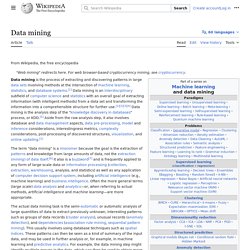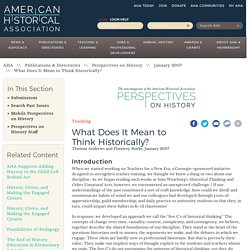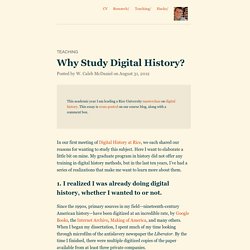

JSTOR. Digital History – "Engaging in online public discourse about digital history." Data mining - Wikipedia. Data mining is the process of discovering patterns in large data sets involving methods at the intersection of machine learning, statistics, and database systems.[1] Data mining is an interdisciplinary subfield of computer science and statistics with an overall goal to extract information (with intelligent methods) from a data set and transform the information into a comprehensible structure for further use.[1][2][3][4] Data mining is the analysis step of the "knowledge discovery in databases" process or KDD.[5] Aside from the raw analysis step, it also involves database and data management aspects, data pre-processing, model and inference considerations, interestingness metrics, complexity considerations, post-processing of discovered structures, visualization, and online updating.[1] Etymology[edit] In the 1960s, statisticians and economists used terms like data fishing or data dredging to refer to what they considered the bad practice of analyzing data without an a-priori hypothesis.

What Does It Mean to Think Historically? Introduction When we started working on Teachers for a New Era, a Carnegie-sponsored initiative designed to strengthen teacher training, we thought we knew a thing or two about our discipline.

As we began reading such works as Sam Wineburg's Historical Thinking and Other Unnatural Acts, however, we encountered an unexpected challenge.1 If our understandings of the past constituted a sort of craft knowledge, how could we distill and communicate habits of mind we and our colleagues had developed through years of apprenticeship, guild membership, and daily practice to university students so that they, in turn, could impart these habits in K–12 classrooms? In response, we developed an approach we call the "five C's of historical thinking. " The concepts of change over time, causality, context, complexity, and contingency, we believe, together describe the shared foundations of our discipline.
Change over Time The idea of change over time is perhaps the easiest of the C's to grasp. Context Notes. Why Study Digital History? Teaching Posted by W.

Caleb McDaniel on August 31, 2012 In our first meeting of Digital History at Rice, we each shared our reasons for wanting to study this subject. Here I want to elaborate a little bit on mine. My graduate program in history did not offer any training in digital history methods, but in the last ten years, I’ve had a series of realizations that make me want to learn more about them. 1. Since the 1990s, primary sources in my field—nineteenth-century American history—have been digitized at an incredible rate, by Google Books, the Internet Archive, Making of America, and many others. It would be foolish not to make use of these resources, so I do—all the time. The more I began to think about this issue, the more I realized how ubiquitous these invisible collaborations were in my day-to-day work; every time I entered a query into Google, or fired up Microsoft Excel, I was, if not programming, at least being programmed and relying on the programming others had done.
Ngram Viewer. About Fusion Tables - Fusion Tables Help. Bust your data out of its silo!

Get more from data with Fusion Tables. Fusion Tables is an experimental data visualization web application to gather, visualize, and share data tables. Visualize bigger table data online Filter and summarize across hundreds of thousands of rows. Then try a chart, map, network graph, or custom layout and embed or share it. Two tables are better than one! Merge two or three tables to generate a single visualization that includes both sets of data. Make a map in minutes Host data online - and stay in control Viewers located anywhere can produce charts or maps from it. Visualize bigger table data online Import your own data Upload data tables from spreadsheets or CSV files, even KML.